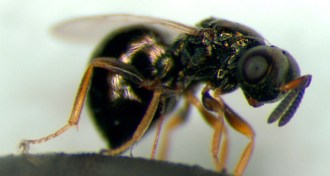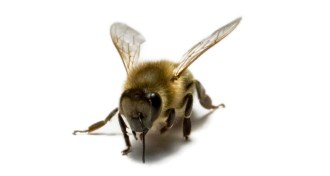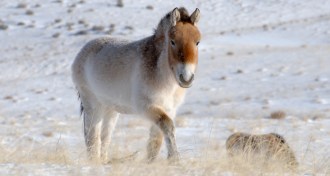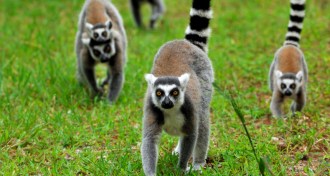News
-
 Animals
AnimalsGut microbes may put barrier between species
Wiping out gut bacteria in wasps saves crossbred offspring from death, suggesting that microbes may play a role in speciation.
By Susan Milius -
 Animals
AnimalsHoneybees use right antennae to tell friend from foe
Asymmetry in sense of smell alters insects' behavior in lab tests.
-
 Earth
EarthFaults can reseal months after quakes
Measurements in southern China find quick healing of fractured rock.
By Erin Wayman -
 Science & Society
Science & SocietyMath targets cities’ essence
New formula relates city size to infrastructure, productivity.
-
 Tech
TechTwisted light transmits more data
Spiral beams allow multiple information streams in one cable.
By Andrew Grant -
 Life
LifeAncient horse’s DNA fills in picture of equine evolution
An entire genome compiled from a 700,000-year-old bone yields new information about equine history.
-
 Animals
AnimalsLemurs’ group size predicts social intelligence
Primates that live with many others know not to steal food when someone is watching.
-
 Humans
HumansHard throwers evolved a long time ago
Baseball hurlers provide clues to the ancient roots of bodies that can heave objects really fast.
By Bruce Bower -
 Health & Medicine
Health & MedicineParalyzed rats relearn to pee
Bladder control restored for the first time in animals with stark spinal cord damage.
By Meghan Rosen -
 Earth
EarthCleaner air may have brought more storms
Pollution during the 20th century appears to have suppressed North Atlantic hurricanes.
-
 Particle Physics
Particle PhysicsFirst four-quark particle may have been spotted
If confirmed, the tetraquark could shed light on how atomic nuclei are held together.
By Andrew Grant -
 Health & Medicine
Health & MedicineHuman brain mapped in 3-D with high resolution
“BigBrain” model, the most detailed atlas yet, could improve brain scanning tools and neurosurgeons’ navigation.
By Meghan Rosen